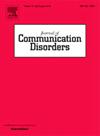The perceptions, attitudes and experiences of service users with telehealth speech-language pathology services
IF 2.1
3区 医学
Q2 AUDIOLOGY & SPEECH-LANGUAGE PATHOLOGY
引用次数: 0
Abstract
Aims
To investigate the perceptions, attitudes, and experiences of clients and caregivers towards telehealth Speech-Language Pathology (SLP) services.
Methods
A comprehensive questionnaire was developed and validated to investigate the perceptions, attitudes, and experiences of service users towards telehealth services. The questionnaire included questions related to telehealth experience, client's preferences, and the perceived facilitators, barriers, advantages, and disadvantages of telehealth. Phone survey was used to collect data from clients and caregivers of clients who received telehealth SLP services during and after the COVID-19 pandemic.
Results
A total of 293 clients and caregivers participated in this study. The findings indicated that 97.95 % of the respondents reportedly received telehealth SLP services for the first time during the COVID-19 pandemic, mainly through video-communication (51.2 %), and for different clinical services, with therapy (31.04 %) and monitoring (31.28 %) being the highest services. Of the total respondents, 54.95 % felt that telehealth appointments were similar to in-person appointments. However, 41.30 % of the respondents preferred receiving in-person appointments. Statistical analyses indicated that eight factors were perceived by service users as significant primary facilitators of telehealth (e.g., good internet connection, available resources, experience with technology), whereas only three factors were perceived as significant primary barriers (e.g., poor image/sound quality, and client's communication impairments). Furthermore, 10 factors were perceived as significant primary advantages of telehealth (e.g., reduced cost and travel time), while only one factor was identified as a significant primary disadvantage (inability to conduct a physical examination).
Conclusions
Service users identified numerous advantages of telehealth, including improved access to healthcare, and reduced costs, while only one disadvantage was identified (lack of physical examinations). The perceived facilitators and barriers of telehealth by service users can be classified into technology-related factors (e.g., comfort with technology, internet connection) and client-related factors (e.g., client's cognitive and sensory abilities). These technology and client-related factors should be considered by policy makers and funding bodies while planning the establishment or expansion of telehealth services.
远程卫生语言病理学服务使用者的认知、态度和经验
目的调查客户和护理人员对远程医疗语音语言病理学(SLP)服务的看法、态度和经验。方法编制并验证了一份综合问卷,调查服务使用者对远程医疗服务的看法、态度和体验。问卷包括与远程医疗经验、客户偏好以及远程医疗的感知促进因素、障碍、优势和劣势相关的问题。通过电话调查收集在COVID-19大流行期间和之后接受远程医疗SLP服务的客户及其护理人员的数据。结果共293名患者及护理人员参与本研究。调查结果显示,据报告,97.95%的受访者在2019冠状病毒病大流行期间首次获得远程医疗服务,主要是通过视频通信(51.2%)和不同的临床服务,其中治疗(31.04%)和监测(31.28%)是最高的服务。在所有受访者中,54.95%的人认为远程医疗预约与面对面的预约相似。然而,41.30%的受访者更喜欢接受面对面的预约。统计分析表明,服务用户认为有8个因素是远程保健的重要主要促进因素(例如,良好的互联网连接、现有资源、技术经验),而只有3个因素被认为是重要的主要障碍(例如,图像/声音质量差和客户沟通障碍)。此外,10个因素被认为是远程保健的重要主要优势(例如,降低成本和旅行时间),而只有一个因素被确定为重大主要劣势(无法进行体检)。结论服务用户确定了远程保健的许多优点,包括改善获得保健的机会和降低成本,而只确定了一个缺点(缺乏体检)。服务使用者认为的远程保健的促进因素和障碍可分为与技术有关的因素(例如,对技术的适应程度、互联网连接)和与客户有关的因素(例如,客户的认知和感觉能力)。决策者和供资机构在规划建立或扩大远程保健服务时,应考虑这些与技术和客户有关的因素。
本文章由计算机程序翻译,如有差异,请以英文原文为准。
求助全文
约1分钟内获得全文
求助全文
来源期刊

Journal of Communication Disorders
AUDIOLOGY & SPEECH-LANGUAGE PATHOLOGY-REHABILITATION
CiteScore
3.30
自引率
5.90%
发文量
71
审稿时长
>12 weeks
期刊介绍:
The Journal of Communication Disorders publishes original articles on topics related to disorders of speech, language and hearing. Authors are encouraged to submit reports of experimental or descriptive investigations (research articles), review articles, tutorials or discussion papers, or letters to the editor ("short communications"). Please note that we do not accept case studies unless they conform to the principles of single-subject experimental design. Special issues are published periodically on timely and clinically relevant topics.
 求助内容:
求助内容: 应助结果提醒方式:
应助结果提醒方式:


